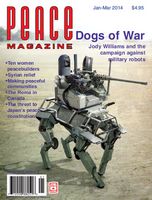
Peace Magazine Jan-Mar 2014, page 13. Some rights reserved.
Search for other articles by John Bacher here
It is revealing that the lifelong struggle for peace by the Arab-Israeli priest Elias Chacour is so little known. Chacour, now the Archbishop of Galilee in the Melkite Greek Catholic church, has been nominated for the Nobel Peace Prize—in part to make his struggles for peace in a land torn by violence and hatred better understood. And his struggle may be returning to the Israeli political agenda as public support grows for parties historically linked to the peace movement.
Like many Palestinians who live within the post-1948 borders of Israel, Chacour’s life has been shaped by the strange circumstances of being an internal refugee. Many Palestinians who were exiled from their traditional communities following the 1948 war of independence were able to remain within Israel.
Chacour was born in the traditional Melkite Catholic community of Biram in northern Galilee. In 1952, the villagers saw their homes destroyed and their olive groves seized by the Israeli army, in defiance of a Supreme Court ruling. Chacour’s family was able to settle in the neighboring Palestinian Christian community of Jish, as the rest of the village’s population was dispersed through northern Israel, Lebanon, and further abroad.
Chacour trained to be a priest in at the Seminary of St. Sulpice in Paris (the Israeli government would not permit him to study in East Jerusalem, which was at the time under Jordanian sovereignty). As a young priest, he distinguished himself by taking up the tactics of nonviolent protest, modeled on the Christian-led American civil rights movement. One of his early actions was to repair Biram’s Church of Notre Dame “as a symbol of hope for the Palestinian people.” The church had been damaged but not destroyed by the Israeli army in 1953, although the rest of the village had been shelled.
Chacour’s nonviolent activism was fostered when Pope Paul VI appointed Joseph Raya to be Bishop of Galilee in 1968. Raya was a Lebanese-American working in the US Deep South where he witnessed, and participated in, the civil rights movement. He had been a friend of Martin Luther King, praying and marching at his side, as Chacour recalled in his first book, Blood Brothers: from Birmingham to Selma to Washington, D.C.
With the support of prominent rabbis and professors from the Hebrew University, Chacour was able to organize a peace march of several thousand people — Jews, Christians, Muslims and Druze – on the Knesset
Following the election of Yitzhak Rabin as Prime Minister in 1992, Chacour came close to securing the return of Biram’s internally displaced residents. Rabin (whose minority government relied on support from Palestinian legislators in the Knesset) was committed to improving the situation for Israel’s Arabic speaking minority. Part of these efforts—which also involved substantial investments in infrastructure in Palestinian communities—wasto make a settlement proposal with the Biram villagers.
An offer was made to restore 600 hectares of Biram’s land. However, this was refused, since to gain the land the displaced had to sign an agreement to give up their claim to a much larger area of around 11,000 hectares. Despite the initial rejection, talks continued until they were broken off following Rabin’s assassination in 1995.
The failure of subsequent Israeli governments to negotiate with the exiled of Biram illustrates the cowardly, lacklustre cabinets that have followed those led by Rabin until his death.
Recent developments are showing hopeful signs — prophesied by Chacour in his 2008 book, Faith: Beyond Despair: Building Hope in the Holy Land. Here he predicted that eventually, despite the bad example of Israel’s only female prime minister, Golda Meir, women would “play an important part in the creation of peace in Israel.”
As Chacour puts it, although in many ways Israel is a “modern and democratic state,” such tendencies are undermined by the influence of religious parties which “do not recognize the rights of women.” In these prophecies, Chacour was influenced by the growing ongoing dialogue between Jewish and Arab women, fostered by such figures as the Palestinian Anglican and legislator, Hanan Ashrawi.
The newly selected head of the Meretz Party, Zahava Gal-On, is part of that tradition. She has sponsored legislation for the return of Biram and Ikirt. (Ikirt is another Palestinian Christian community whose land was seized in defiance of the Israeli Supreme Court.) In defence of her legislation, Gal-On has stressed that the return of the land would be “a correct, moral, and just decision that will prove that Israel honors and keeps its priorities” and “obeys judicial decisions.” Her views were endorsed by the influential Israeli newspaper, Haaretz, which saw the opposition to her efforts as exposing the government’s “moral and political lacunae.”
Gal-On, who rose to leadership by denouncing her colleagues’ support for the Gaza war, is rising in the polls and has developed a plan to replace the Oslo Accords. Part of this is an end to all settlement activities on the West Bank.
While he may seem a voice in the wilderness, in this regard Archbishop Chacour is similar to peace advocates during the years of the Cold War. In his uncompromising defence of peace based on the principles of love and justice, Chacour is loyal to his faithful Melkite Christian ancestors. His father, Michael, would gather his family “under the open stars or around a low fire as the winter wind beat at our door.” Here he would explain how their Melkite ancestors would combat the first century Gnostic heretics by uniting the previously “splintered churches.” Just as his ancestors challenged Gnostic teachings which ignored the reality of suffering on earth, Chacour’s mission has been to (nonviolently) combat the heresies of our own time—and in doing so, restoring the foundation of love which unites the three great Abrahamic faiths.
John Bacher is a writer in St Catharines, Ontario.

Peace Magazine Jan-Mar 2014, page 13. Some rights reserved.
Search for other articles by John Bacher here